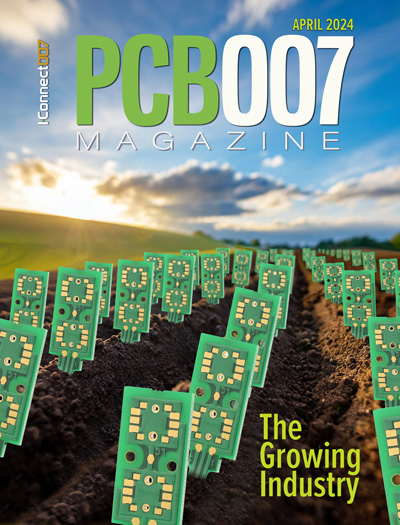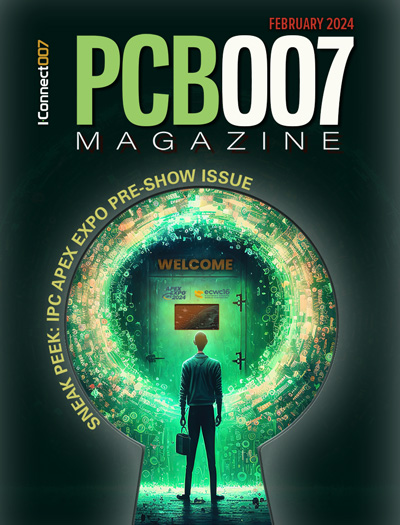-

- News
- Books
Featured Books
- pcb007 Magazine
Latest Issues
Current Issue
The Growing Industry
In this issue of PCB007 Magazine, we talk with leading economic experts, advocacy specialists in Washington, D.C., and PCB company leadership to get a well-rounded picture of what’s happening in the industry today. Don’t miss it.

The Sustainability Issue
Sustainability is one of the most widely used terms in business today, especially for electronics and manufacturing but what does it mean to you? We explore the environmental, business, and economic impacts.

The Fabricator’s Guide to IPC APEX EXPO
This issue previews many of the important events taking place at this year's show and highlights some changes and opportunities. So, buckle up. We are counting down to IPC APEX EXPO 2024.
- Articles
Article Highlights
- Columns
Search Console
- Links
- Events
||| MENU - pcb007 Magazine
Happy’s Essential Skills: CIM and Automation Planning, Part 1
August 31, 2016 | Happy HoldenEstimated reading time: 13 minutes
There is a lot of talk and even information about automation, but I find that there is very little available on automation planning. This is one of my specialties. I started by getting a master's in EE in control theory. This went well with my B.S. in chemical engineering as I specialized in process control and IC manufacturing. This is one reason I took my first job at Hewlett-Packard; they wanted to automate the IC production, even back in 1970. I discovered then that there were a lot of companies offering equipment and software, but not a strategy on “How to Automate!” So working with HP Labs, we developed a ‘methodology’ that has worked for HP very well over the years. In my next column, I will focus on computer-aided-manufacturing and the connectivity issues with different protocols available.
However, the benefits will be derived only if certain cardinal principles are observed. This column outlines, briefly, the background of computer-integrated-manufacturing (CIM) and six of those automation principles: Superiority, Simplicity, Flexibility, Compatibility, Manufacturability, and Reliability.
Introduction
The consistent characteristic of successful application of automation in manufacturing has been the degree to which business and technical management understands and promotes the strategies, tactics, and philosophies used in modern manufacturing. By reviewing these philosophies of CIM, automation, management roles, mechanization, SPC, TQC, LEAN, MRP and Design for Manufacturing the successful implementation of automation in any company, small as well as large, will be enhanced.
Computer Integrated Manufacturing (CIM)
The strategies outlined here are considered CIM. HP was once in the business of selling CIM and called it “The Manufacturers Productivity Network” or MPN. The products were various software, computers, networking, interfaces and measurement systems. HP had been in this business for a long time—longer than any other company. It started with government’s and others’ request for automated test and measurement systems. Because of the need to automate various measurement instruments/systems, HP created the first machine-to-machine protocol called “HP-Interface Bus” or HP-IB. This was later formulized into the IEEE-488 Communication Standard. HP needed an “Instrument Controller” and so purchased a unique 16-bit computer architecture from Union Carbide (unique in that the operating system was ‘real time and interrupt driven’). This became the HP2116 in 1964. This computer was unique in that it had space for 16 interface cards for measurement instrument. What HP didn’t realize was that many companies were using the computer, not with instruments, but with multiple input terminals and printers, creating the first ‘Time-share-systems’. So HP created a smaller and lower cost version, called the HP2114. This led to the world’s first time-share system, the HP2000. Later, this would evolve to a multi-user business system called the HP3000 and used what they called the HP-Precision Architecture (HP-PA). Today, only six Enterprise Hardware architectures have survived (all American) the endless computer wars; HP-PA, IBM’s POWER architecture, Sun’s SPARK, AMD X86-64 and Intel’s XEON and Itanium.
The CIM Architecture was defined as early as 1980, when the CASA/SME[1] published a presentation of computer integrated manufacturing in order to provide a common set of terms for its members. As published by CASA/SME, the CIM Wheel of 1980 definition was:
The ring surrounding the wheel represents various influencing factors (man and his degree of expertise as the human factor, productivity as the economic factor and computer technology as the technological factor) for the development of CIM.
The updated CIM wheel (1986) contained the following:
The wheel itself contains four functions, namely engineering design, manufacturing planning, production control and factory automation. If the individual functions are connected with each other and operate with a common database, an integrated system architecture is created which is represented by the hub of the wheel. This development has resulted in the realization that CIM, apart from factory automation and functions indirectly related to the operational performance such as design (product/process) and production planning and control, is also linked to common business administrative tasks such as manufacturing management, strategic planning, finance, marketing and human resource management. A further innovation was the addition of information resource management and communications between the different functions. Therefore, a common database alone is insufficient for achieving integration. The all-embracing nature of the CIM wheel reflects the idea promoted by CASA/SME that CIM has to be viewed as a concept embracing the company as a whole.
Figure 1: The CIM Wheel defined by CASA/SME[1].
The outer ring
The common business administrative tasks related to CIM are located on the outer ring of the wheel. They mainly form the connection of the company to the outside world in general. Data processing applications can be found in the most diverse areas. Most software systems applied in these areas were originally self-styled developments, which are increasingly being replaced with commercial standard software packages. Currently this software is installed primarily on mainframes. Overlaps of its functionality exist mainly with the software of the production planning and control.
The inner ring
On the inner ring of the wheel, the functions closely related to the operational performance of the company are situated. Data processing applications of the development and design area are computer aided design (CAD), simulations, analysis programs such as the finite element method (FEM) as well as drawing storage and management, for instance with the help of group technology (GT).
The types of data found in this area are diverse: drawings, technical specifications, and bills of material. In manufacturing companies, the data itself are often in considerable disorder. Frequently there are several types of part numbers, more than one group technology system, many kinds of bills of material, a number of different CAD systems each having its own sort of computer internal representation of geometric data, etc. The applied software rarely runs on the same hardware, resulting also in a large number of different hardware systems.
The second group of applications on the inner ring of the wheel is attributed to process planning and production planning and control. It comprises tasks such as routing generation, resource planning, material requirements planning, capacity planning, order distribution and supervision, but also the planning of quality assurance (quality process and resource planning). In the USA, software in the production planning and control area mostly runs on large client/servers, although the software itself is more often than not supplied by sundry software houses and not by the computer vendor. As in the common business administrative area, the software packages—which at least are integrated within themselves—have a modular structure and their single components can also be bought and applied. Therefore, a company rarely has purchased and installed all modules of such a package, which in turn frequently results in functional overlaps and data redundancy (one example: material requirements planning and purchasing systems).
The third group on the inner ring includes the automation of the manufacturing installations. Examples are robots, numerically controlled machines, flexible manufacturing systems and computer-aided measuring and testing methods. This area is characterized by the extreme heterogeneity of the systems involved, the diversity of which being much more pronounced than in the previously mentioned groups of functions. Another view is the CIM Hierarchy, as seen in Figure 2.
The hub
The statements made above have already shown that at present within these groups of applications there are serious impediments with regard to integration. There are few suppliers covering all three sectors. Therefore, little or nothing has been done by the suppliers with regard to interfaces, not to mention the integration of the various groups of applications. Information and communication management, represented by the hub of the wheel which links everything, is intended to serve as the information management and communication control function between the single areas. It operates on a common, integrated database.
Figure 2: The seven arenas of a CIM strategy.
Page 1 of 4
Suggested Items
Real Time with… IPC APEX EXPO 2024: Tools, Training, and Trends in Manufacturing Engineering
04/25/2024 | Real Time with...IPC APEX EXPOGuest Editor Kelly Dack and Product Specialist Erik Bateham of Polar Instruments discuss Polar's latest technology, including their role in aiding manufacturing engineers. They highlight the advanced capabilities of Polar's tools and the critical role of signal integrity analysis, as well as the importance of accurate modeling in board manufacturing. Polar's unique training approach and demonstration contact details are also explored.
TTM Celebrates the Grand Opening of Its First Manufacturing Facility in Penang
04/25/2024 | TTM Technologies, Inc.TTM Technologies, Inc., a leading global manufacturer of technology solutions including mission systems, radio frequency (RF) components and RF microwave/microelectronic assemblies, and quick-turn and technologically advanced printed circuit boards (PCBs), officially opened its first manufacturing plant in Penang, Malaysia with an investment of USD200 million (approximately RM958 million).
Listen Up! The Intricacies of PCB Drilling Detailed in New Podcast Episode
04/25/2024 | I-Connect007In episode 5 of the podcast series, On the Line With: Designing for Reality, Nolan Johnson and Matt Stevenson continue down the manufacturing process, this time focusing on the post-lamination drilling process for PCBs. Matt and Nolan delve into the intricacies of the PCB drilling process, highlighting the importance of hole quality, drill parameters, and design optimization to ensure smooth manufacturing. The conversation covers topics such as drill bit sizes, aspect ratios, vias, challenges in drilling, and ways to enhance efficiency in the drilling department.
Elevating PCB Design Engineering With IPC Programs
04/24/2024 | Cory Blaylock, IPCIn a monumental stride for the electronics manufacturing industry, IPC has successfully championed the recognition of the PCB Design Engineer as an official occupation by the U.S. Department of Labor (DOL). This pivotal achievement not only underscores the critical role of PCB design engineers within the technology landscape, but also marks the beginning of a transformative journey toward nurturing a robust, skilled workforce ready to propel our industry into the future.
Fujitsu, METRON Collaborate to Drive ESG Success
04/24/2024 | JCN NewswireFujitsu Limited and METRON SAS, a French cleantech company specializing in energy management solutions for industrial decarbonization, today announced a strategic initiative to contribute to the realization of carbon neutrality in the manufacturing industry.


